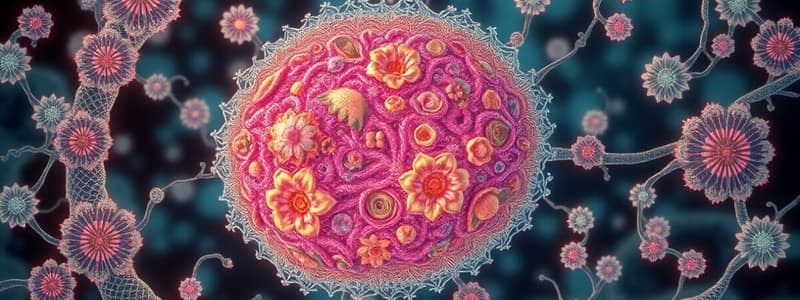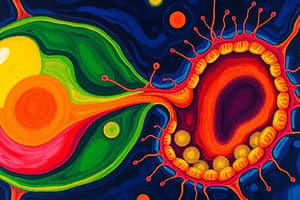Podcast
Questions and Answers
What is the primary function of ribosomes in a eukaryotic cell?
What is the primary function of ribosomes in a eukaryotic cell?
- Site of protein synthesis (correct)
- Site of cell respiration
- Site of DNA synthesis
- Site of lipid metabolism
Which structure in eukaryotic cells is responsible for modifying and packaging proteins?
Which structure in eukaryotic cells is responsible for modifying and packaging proteins?
- Endoplasmic reticulum
- Golgi apparatus (correct)
- Nucleus
- Lysosome
Which type of flagella arrangement has one flagellum at one pole of the cell?
Which type of flagella arrangement has one flagellum at one pole of the cell?
- Monotrichous (correct)
- Amphitrichous
- Lophotrichous
- Petrichous
What differentiates a eukaryotic cell from a prokaryotic cell?
What differentiates a eukaryotic cell from a prokaryotic cell?
What is the role of the smooth endoplasmic reticulum?
What is the role of the smooth endoplasmic reticulum?
Which structure is NOT typically found in prokaryotic cells?
Which structure is NOT typically found in prokaryotic cells?
What are the thickest fibers making up the cytoskeleton?
What are the thickest fibers making up the cytoskeleton?
What is the primary function of chloroplasts in plant cells?
What is the primary function of chloroplasts in plant cells?
Study Notes
Endosymbiotic Theory
- Proposes that certain organelles within eukaryotic cells originated as independent prokaryotic cells engulfed by host cells.
- This theory explains the presence of mitochondria and chloroplasts in eukaryotic cells.
Prokaryotic Cells
- Lack a nucleus, but contain a nucleoid region where DNA is located.
- Have a plasma membrane composed of phospholipids and proteins.
- Possess a cell wall made of peptidoglycan, providing structural support.
- May have a glycocalyx, an outer coating that can act as a slime layer.
- Use flagella for locomotion, with various arrangements:
- Monotrichous: One flagellum at one pole.
- Lophotrichous: Many flagella at one pole.
- Peritrichous: Flagella distributed around the cell.
- Amphitrichous: One flagellum at each pole.
- Contain ribosomes, composed of RNA and protein, responsible for protein synthesis.
Eukaryotic Cells
- Possess a nucleus and membrane-bound organelles, making them more complex than prokaryotic cells.
- Include plants, animals, fungi, and protists.
Nucleus
- Contains the majority of the cell's genetic material.
- Houses chromatin, which forms chromosomes during cell division.
- Contains a nucleolus, the site of ribosomal RNA synthesis.
- Enclosed by a nuclear envelope, a double phospholipid bilayer.
- Contains nuclear pores that regulate the passage of molecules between the nucleus and cytoplasm.
- Supported by a nuclear lamina, which maintains its shape.
Endoplasmic Reticulum
- Network of interconnected membranous sacs and tubules.
- Divided into smooth and rough endoplasmic reticulum:
- Smooth ER: Synthesizes lipids, metabolizes carbohydrates, detoxifies, and stores calcium.
- Rough ER: Contains ribosomes, responsible for protein synthesis and secretion, and the distribution of transport vesicles.
Golgi Apparatus
- Modifies, manufactures, and packages proteins and lipids.
- Transports these molecules in vesicles.
Lysosomes
- Membrane-bound organelles containing enzymes that digest macromolecules.
- Involved in three processes:
- Phagocytosis: Engulfing cells or particles to form vacuoles.
- Phagolysosomes: Fusion of lysosomes with vacuoles.
- Autophagy: Degrading damaged or unnecessary cellular components.
Vacuoles
- Large, fluid-filled sacs within cells.
- Types include:
- Food vacuoles: Store ingested food.
- Contractile vacuoles: Pump excess water out of the cell.
- Central vacuoles: Found in plant cells, providing storage and structural support.
Mitochondria
- Powerhouse of the cell, responsible for cellular respiration.
- Generates ATP (adenosine triphosphate), the energy source for cellular processes.
- Contains two membranes:
- Outer membrane: Smooth and surrounds the entire organelle.
- Inner membrane: Folded into cristae, increasing surface area for ATP production.
Chloroplasts
- Found in plants and algae, containing chlorophyll, the green pigment necessary for photosynthesis.
- Composed of:
- Thylakoids: Interconnected membranous sacs.
- Stroma: Internal fluid.
Peroxisomes
- Small, membrane-bound organelles that convert hydrogen peroxide to water.
- Important for detoxification.
Cytoskeleton
- Network of protein fibers that supports the cell, maintains its shape, and facilitates movement.
- Composed of three types of fibers:
- Microtubules: The thickest fibers, involved in controlling the beating of cilia and flagella.
- Microfilaments: The thinnest fibers, contributing to cell structure, organization, and movement.
- Intermediate filaments: Provide structural support, anchoring organelles and strengthening the cell.
Studying That Suits You
Use AI to generate personalized quizzes and flashcards to suit your learning preferences.
Related Documents
Description
This quiz explores the Endosymbiotic Theory and compares prokaryotic and eukaryotic cells. You'll test your knowledge on the origin of organelles, the structure of prokaryotic cells, and the complexities of eukaryotic cells. Perfect for students looking to reinforce their understanding of cell biology.




